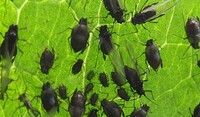Maximising sugar beet weed control with post-emergence treatments
Effective weed control can boost sugar beet yields by as much as 10-20% compared to crops where inadequate control is achieved. It therefore makes sense to mitigate any missed pre-emergence treatments with the application of a suitable post-emergence programme of herbicides.
The residual and contact action of metamitron and quinmerac make these two of the key herbicides to use where a pre-emergence treatment hasn’t been applied. Products such as GOLTIX 70 SC (700g/l metamitron) and GOLTIX TITAN (525g/l metamitron and 40g/l quinmerac) both help to delay the emergence of weeds until sugar beet crops (which are notoriously sensitive to many herbicides) have developed some resilience to subsequent contact treatments. Using GOLTIX TITAN also provides a good opportunity to control ALS-resistant poppy, chickweed and mayweed. It is also a useful start to programmes targeting fool’s parsley.
GOLTIX 70SC is one of the safest herbicides for post-emergence applications in sugar beet and can be applied even when the crop is very small (provided the crop is not under stress). As such, the first application of GOLTIX 70SC should be made at the cotyledon stage of the earliest germinating weeds.
GOLTIX TITAN is also very crop safe and can be applied from the point at which cotyledons are fully unfolded.
Both GOLTIX 70SC and GOLTIX TITAN can be used in combination with additional active ingredients including phenmedipham, ethofumesate, lenacil and triflusulfuron-methyl. It is however worth bearing in mind that the latter two actives have the potential to cause some negative crop effects, notably if the crop is stressed. Where this is the case, the use of lenacil and/or triflusulfuron-methyl should be delayed until T2 and T3, with the T1 dose of metamitron increased to 1.65l/ha in order to prolong and maximise herbicide performance.
Two of these additional active ingredients, phenmedipham and ethofumesate, are available as POWERTWIN (200 g/L phenmedipham and 200 g/L ethofumesate) which gives lasting protection against broad leaved weeds and as such is the ideal partner for GOLTIX 70SC and GOLTIX TITAN.
Ethofumesate is also available as a standalone active in ETHOSAT (ethofumesate 500 g/L) and is an essential component in the control of black bindweed (Fallopia convolvulus). ETHOSAT also provides good control of a wide range of additional grasses and weeds including cleavers, common chickweed, common field speedwell, field penny-cress, fat hen, shepherd’s purse and common fumitory.
For maximum efficacy, post-emergence herbicides in sugar beet should be applied in conjunction with an oil-based adjuvant, although consideration should also be given to the timing of application: to prevent scorching, spray earlier in the morning when daytime temperatures are forecast to exceed 21oC.
FALCON (100g/l propaquizafop) can be also used as a post-emergence treatment in sugar beet and is of particular benefit where grass weeds such as Annual Meadow Grass and volunteer cereals are a concern (for example after cover-cropping).

For more information about any of the active ingredients or herbicides mentioned, please visit the ADAMA sugar beet weed control page at https://www.adama.com/uk/en/current-recommendations/sugarbeet


